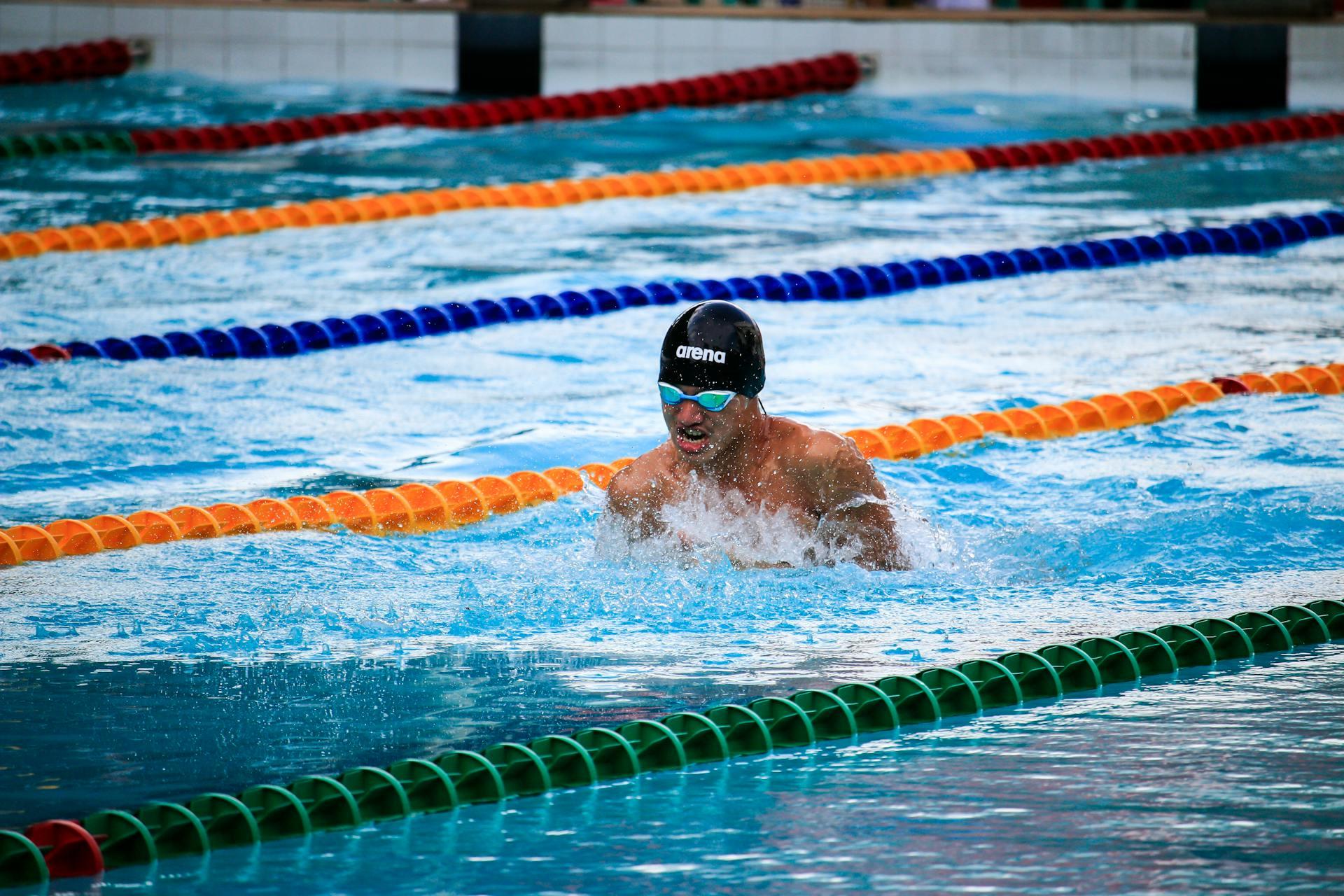Here at "Fun Advanced Swim Drills," we'll reveal the techniques for achieving peak swimming performance. The top ten swim drills that have been carefully chosen to improve your abilities and effectiveness in the water are shown in this blog.
Every drill, from freestyle to butterfly, focuses on a different area of your stroke mechanics and is informed by the knowledge of elite instructors. Come along on this voyage to swimming proficiency with us, and use our carefully chosen drills to reach your full swimming ability.
The first and most important part of learning to swim is to learn to be relaxed in the water. That's why this blog may be helpful to you. Together, let's jump in and create waves!
The top ten swim drills, arranged according to difficulty level, are shown below, along with their advantages and target areas.
The top ten swim drills, arranged according to difficulty level, are shown below, along with their advantages and target areas.
Check this blog to understand the fundamentals of swimming before going deep into the drills.


Closed-Fist Freestyle
Swimming freestyle with closed fists minimizes hand surface area and emphasizes forearm engagement. This drill is known as closed-fist freestyle. Swimmers can learn to focus on engaging their forearms instead of just their hands for movement with this workout.
It also promotes a more remarkable elbow recovery, which results in a more effective stroke. The forearm feels for the water can be improved, and a stronger catch can be encouraged using closed-fist freestyle. Because it reinforces basic stroke mechanics, it is appropriate for beginners.
Benefits: Encourages high elbow recovery and improves forearm feel in the water.
Ideal for: Increasing stroke efficiency and forearm engagement.
Level of difficulty: Beginner (3 out of 10)
Finger Trail
Swimmers in the Finger Trail must sweep their fingertips through the water's surface, keeping their elbows raised. This drill emphasizes precise body rotation and arm posture, which promotes a narrow and effective stroke.
Swimmers attain excellent body rotation and streamlined placement by closely pressing the shoulder of their leading arm to the chin during extension. The most effective method for improving stroke speed and developing a more effective freestyle stroke is the Finger Trail. Swimmers from basic to intermediate skill levels can use it.
Benefits: Enhances body rotation and develops an efficient stroke with a high elbow recovery.
Ideal for: Mastering a fluid and effective freestyle stroke.
Level of difficulty: Beginner (4 out of 10)
Unco
Unco is swimming freestyle, extending one arm while keeping the other at your side, switching up your breathing and side strokes. Swimmers must coordinate their body rotation and stroke timing while breathing bilaterally during this workout.
Unco helps enhance body rotation, breathing timing, and stroke coordination by imposing an uncomfortable stroke pattern. It is helpful for intermediate swimmers looking to improve breathing efficiency and stroke symmetry.
Benefits: Improves body rotation, breathing timing, and stroke coordination.
Ideal for: Enhancing stroke symmetry and bilateral breathing.
Level of difficulty: Amateur (5 out of 10)
Freestyle Using Dolphin Kicks
Dolphin kicks are combined with freestyle arm motions to create a rhythmic and effective stroke known as "Freestyle with Dolphin Kicks."
Swimmers can improve their stroke rate and establish a fluid stroke rhythm with the help of this workout. Swimmers can strengthen their core muscles and improve their overall propulsion by implementing dolphin kicks.
Dolphin kicks in freestyle can be awkward at first, but they eventually enhance the speed and efficiency of the stroke. Intermediate swimmers who want to improve their technique and swim faster should try it.
Benefits: Promotes high elbow catch, improves stroke rhythm, and raises stroke rate.
Ideal for: Increasing arm-leg coordination during freestyle.
Level of difficulty: Amateur (6 out of 10)
Six-Kick Switch
In the 6-Kick Switch, you must balance on one side and execute six kicks before switching to the other and performing one stroke. This exercise improves continuous rotation and balance, resulting in a smoother and more effective freestyle stroke.
Swimmers improve stroke harmony and coordination by preserving correct body alignment and rotation. For intermediate to expert swimmers looking to improve their technique and boost swim efficiency, the 6-Kick Switch is a good option.
Benefits: Enhances balance and continuous rotation in freestyle.
Ideal for: Improving symmetry in the stroke and rotation.
Level of difficulty: Amateur (7 out of 10)

Breaststroke Freestyle Legs
Freestyle Legs emphasizes forward momentum and good arm posture by combining freestyle kicking with breaststroke arm technique.
Swimmers can enhance their breaststroke arm pull by concentrating on keeping an aerodynamic position and forward propulsion while using their legs to perform a freestyle kick.
This workout will benefit beginners who want to streamline their stroke and learn good technique. It keeps swimmers moving ahead while assisting them in understanding breaststroke mechanics.
Benefits: Builds arm lift for the breaststroke while preserving forward motion.
Ideal for: Maintaining a streamlined stance and perfecting breaststroke arm technique.
Level of difficulty: Beginner (3 out of 10)
Windshield Wipers
The windshield wiper arm pull simulates the out-sweep of the breaststroke arm pull by sweeping the forearms outward. This practice aims to improve your breaststroke stroke efficiency by stressing good arm positioning and propulsion.
Swimmers can enhance the strength and coordination of their arm pull by keeping their balance and core stable. Windshield Wiper is a good option for intermediate swimmers looking to improve propulsion and refine their breaststroke technique.
Benefits: Teaches the proper arm posture for the breaststroke pull.
Ideal for: Improving breaststroke propulsion and effectiveness.
Level of difficulty: Amateur (5 out of 10)
Rocking
In breaststroke, rocking focuses on generating a cohesive core action and deliberate body movement. Using alternating "glide" and "power" phases, swimmers can improve their rhythm and body control in the breaststroke.
With the aid of this exercise, swimmers can better comprehend the significance of body alignment and core engagement in producing forward motion. For intermediate to advanced swimmers who want to improve their breaststroke form and swim faster, rocking is helpful.
Benefits: Developing a cohesive core motion and rhythm in breaststroke is one of the rocking benefits.
Ideal for: Enhancing breaststroke rhythm and alignment.
Level of difficulty: Amateur (6 out of 10)
Breaststroke Kick on Back
Kicking a breaststroke while lying on one's back and concentrating on knee propulsion and alignment is known as the "breaststroke kick on back." Swimmers can achieve more powerful and effective breaststroke kicks by keeping a streamlined body posture and using good kick technique.
This exercise increases leg strength and coordination while teaching swimmers the principles of the breaststroke kick. Beginners wishing to improve their kick technique and boost their propulsion in the breaststroke can benefit from practicing the breaststroke kick on the back. Knowing how to float can be a good asset in learning this drill faster.
Benefits: Improves knee alignment and forceful breaststroke kicking.
Ideal for: Improving leg strength and breaststroke kick technique.
Level of difficulty: Beginner (4 out of 10)
Closed-Fist Breaststroke:
Closed-fist-balled-ups are required for swimming breaststroke, emphasizing forearm engagement and extended elbows. Breaststroke participants can develop a better catch-and-pull phase using fewer hands during practice.
Swimmers can improve the efficiency and power of their stroke by concentrating on using their forearms for propulsion. For intermediate swimmers looking to improve their breaststroke technique and boost propulsion, the closed-fist breaststroke is a good option.
Benefits: Highlights high elbows and improves forearm feel in the water.
Ideal for: Increasing breaststroke stroke efficiency and forearm engagement.
Level of difficulty: Beginner (5 out of 10)
These workouts offer a systematic approach to technique and performance improvements in the pool, catering to swimmers of all skill levels.
The four basic strokes used in formal swimming competitions are the freestyle, backstroke, breaststroke, and butterfly. The following drills match these fundamental strokes and are utilized in official competitions. Check out to learn about the main swimming strokes that you should know.
Although the other drills on the list are more specific and might not be utilized in actual tournaments, they are still beneficial for improving overall stroke efficiency and technique during training. If you are new to swimming, check out this link for more information.

Wrap up
Both seasoned athletes and aspiring swimmers can discover teachers and trainers who specialize in various swim drills that cater to varying skill levels in Superprof's vast network of swimming courses across Canada.
Superprof offers a wide range of certified teachers who customize their classes to match your specific goals and desires, whether you're a beginner trying to understand the fundamentals or an accomplished swimmer looking to improve your technique.
Because coaches are skilled in various strokes and drills, a swimmer can select teachers according to their requirements. This allows for a customized learning process that improves overall performance in the water and speeds up skills development.
Swimmers may also examine and contrast various coaching profiles on Superprof's website, choosing instructors according to availability, teaching style, and experience. Superprof provides flexible scheduling options to suit multiple learning preferences, whether seeking one-on-one training for complete focus or group sessions for a collaborative learning atmosphere.
A swimmer can experience a life-changing adventure with Superprof's swimming classes, led by knowledgeable coaches who offer priceless advice, encouragement, and support at every step, enabling them to reach their most significant swimming potential.
















